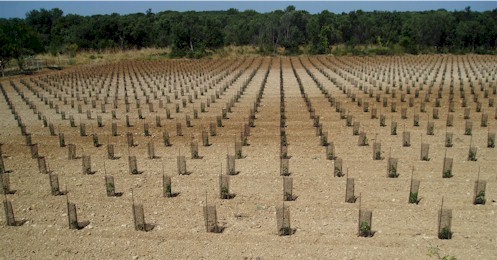The appellation - area and rules
The borders of the appellation was
pointed out by the local wine growers in the 1920s and was legally decided in
court in 1933.
1 Maj 1936 the general rules for the appellation was confirmed by INAO, Institut
National des Appellations d'Origine.
You can eventually read more about the creation of the appellation here
|
|
Area of production
The appellation includes nearly all land in
Chateauneuf du Pape and parts of four other communes: Orange, Courthezon,
Bedarrides, Sorgues. The table below shows the area in the five communes.
Click and discover (in French)
 |
|

|
At the mayor's office in each commune
detailed maps of all included parcels are to be seen on maps. There have not been
changes of the area since 1933. Nearly all cutivailable land inside the
apellation is today planted with vines. Therefore you will not see much change in
the area of production - nearly 3200 hectares.
The allowed grapes
It's always said that the
appellation has 13 allowed grape varieties: Grenache, Syrah, Mourvèdre, Picpoul, Terret Noir, Counoise, Muscardin,
Vaccarèse, Picardan, Cinsault, Clairette, Roussanne, Bourboulenc. It has to
be noticed, that Grenache an Picpoul exists in two different varieties white and red.
More about the grapes here.
|
|
|
Pruning
The pruning method goblet are the
only authorized for Grenache Noir, Mourvèdre, Picpoul Noir and Terret Noir.
Goblet or bilateral cordon de royat trained with two wires are
authorized for Grenache Blanc, Picpoul Blanc, Picardan, Clairette, Roussanne, Bourboulenc,
Muscardin, Vaccarèse, Cinsaut and Counoise.
For Syrah may be used goblet, bilateral cordon de royat or guyot
with a long fruiting cane, with max. 8 eyes.
|
|

Plantation - density
Minimum 3000 plants per hectare.
Maximum 2,5 m between rows.

|
Irrigation
Irrigation is not allowed generally.
Although it's allowed for young vines not yet in production.
In case of very special dry conditions INAO can allow irrigation in limited
periods.
Alcohol degree
Minimum alcohol percent is 13,5
for both white and red wines. Chaptalization is not alloved.
Vinification
Only red and white wines can be
made (excluding rosé wine).
The wine must be made in accordance to local traditions, honest and constant with perfectly healthy
grapes.
During the harvest insufficiently
ripe, damaged or sick parts will
have to be removed as a preliminary for the development of the râpé 1). (Obligatory
sorting)
Grapes from young wines can only be
used after three years of age.
|
|
|
The rosy, stained or faded wines, the damaged or sick wines and the wines with
les than 0,90 grams of
volatile acidity lose the right to the controlled label of origin.
The basic maximum output is 35 hectolitre per
hectar.
This basic output can, for a determined harvest, on proposal of the federation
of the producers of wines of Châteauneuf-of-Pope and taking into account the
quality and of the quantity of this harvest, be lowered or increased, but can
never be more than 42 hectolitres per hectare of vines in production râpé
included.
Any wine grower is imposed to produce, a percentage of "râpé",
variable between 5 and 20 % of the quantities asserted to be Châteauneuf du
Pape. The office of the federation of the producers of wines of "Châteauneuf
du Pape" fixes each year the imposed minimum percentage.
If a producer goes beyond of the annual output or
don't respect the rules for râpé he will lose the right to produce "Châteauneuf-du-Pape".
1) Râpé: wine made of discarded grapes.
|
|
|